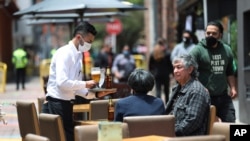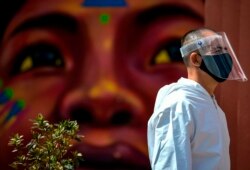When Juan José Hincapié opened his small pizza restaurant on his street corner, the 46-year-old achieved his lifelong dream.
But after five months of quarantine in Colombia, his dream, like those of many people in this nation still recovering from decades of civil war and cartel violence, is in danger of evaporating.
The country is beginning to emerge from one of the world’s longest coronavirus quarantines, which has had devastating effects in regard to poverty, mental health, violence, the economy and small businesses like Hincapié’s.
Now, health experts warn it will have to strike a careful balancing to not spiral out of control.
Two months ago, Hincapié made a snap decision to transform his restaurant in Medellín, Colombia’s second-largest city, into a fruit and vegetable stand. He replaced heavy stoves and tables with plastic bins holding piles of tomatoes, pineapples, potatoes, avocados and other produce.
“If we didn’t make that change, we would have had to close because our sales dropped 80% — even more,” he said. “We couldn’t sustain our staff with that.”
He watched as neighborhood shops around him shuttered for good, “for rent” signs began to pop up, and a growing number of people walked the streets begging for money from apartments looming above.
Unemployment has surged and Colombia’s economy contracted nearly 17% in May compared with the same month in 2019. Meanwhile in June, the World Bank said Latin America would lose 20 years of progress in poverty reduction because of the pandemic.
Cases still rising
Despite the lockdown, cases in the South American country continue to soar.
Colombia now has one of the highest infection rates in the world. As of September 3, the country has reported more than 633,321 confirmed cases and 20,345 deaths.
Luis Jorge Hernández, a public health researcher, sees the rising numbers as a sign that the quarantines have started to do more harm than good.
“We can't continue with more lockdown, we have to work on mitigation, using face masks, washing hands and social distancing,” Hernández said. “It was effective in the beginning, but now it's not effective.”
Colombian President Ivan Duque announced the national quarantine in late March, and for the first weeks, even months, that lockdown appeared to be effective. As cases in other Latin American countries like Mexico and Brazil soared, the infection rate in Colombia stayed comparatively low.
But Colombia, along with other nations with emerging economies in Latin America, faces a set of challenges that makes the pandemic all the more difficult to control.
Extending the quarantines pushed poorer and working-class Colombians to the brink in large part by forcing informal workers – street vendors or laborers who survive on day-to-day wages – to go to work or go hungry.
At the same time, densely populated cities and ill-equipped medical systems fueled pessimism from the beginning about Colombia’s ability to contain the spread of the virus.
As the months went by, the quarantine was lengthened while enforcement grew more flexible and more sporadic. Some cities took a militarized approach, enlisting the help of police to contain the spread, while others experimented with phased lockdowns.
The country is now set to begin reopening this month. Hernández worries about the consequences of relaxing measures too early.
In Medellín, the government announced it would reopen churches, gyms and motels, including some that charge by the hour, this month. Local leaders in Cartagena, a coastal city popular among tourists, have called for the resumption of international flights.
To reopen or not reopen
Health experts warn that the moves could fuel a surge in cases.
“We're at this epidemic peak. If they open too fast, we're going to have another epidemic peak that's worse than the first one,” he said.
Meanwhile, some of the quarantine’s ripple effects may have longer-term implications.
Already, cases of domestic violence have surged, and armed groups have taken advantage of an absence of security forces in key drug routes to wage territorial wars. In recent weeks, rural Colombia has seen a growing wave of massacres, suggesting the country could be reversing significant gains it made over the past two decades in combating drug violence that traumatized generations of Colombians.
Regression?
Reports show enormous jumps in symptoms of anxiety, depression, insomnia and post-traumatic stress reactions. Calls to the national psychological attention line have tripled since April, according to Colombia’s Health Ministry. In the country’s capital of Bogotá, the mayor’s office reported a 21% increase in suicide attempts since the start of the quarantine.
Hernández said he also worries about a deteriorating physical and cardiovascular health of Colombians, which could make individuals more vulnerable to COVID-19.
Single mother Nataly Uribe Franco lives with that anxiety every day.
The 34-year-old works at a family’s ice cream business, Cremas Doña Alba, in Medellín’s Comuna 13. The neighborhood was once ravaged by violence, but in recent years has become a hub for tourists. That tourism provided a key economic lifeline for many working-class families in the zone.
It allowed Uribe Franco’s family to leave their jobs at a plastic bag factory and start their own business. With it, she was able to support herself and two children, now 14 and 16 years old.
But that disappeared along with the tourists.
“There are weeks and months where we don't sell a lot, so I have to ask the owner of our house to wait for me to pay rent,” she said. “I’m so stressed, and I try not to stress too much, because that only makes things worse.”
Painful future
Analysts like Ariel Ávila, deputy director of the Colombian research group, the Peace and Reconciliation Foundation, say while the country struggles to establish its new normal, the quarantine’s effects will span far beyond it.
“The next year is going to be a very tortuous one,” Ávila said, “for the government and all of Colombian society.”
Uribe Franco, too, dreads what lies ahead.
The family had to cut their staff from 15 to five. Promised government aid never arrived, she said. Food distributions from large companies and NGOs that came at the beginning of the pandemic slowly trickled away. Uribe Franco has watched helplessly as other members of the community go hungry.
“People lose hope, they don't know what to do or how to get out of this,” she said. “With a quarantine so long, you begin to feel hopeless.”











